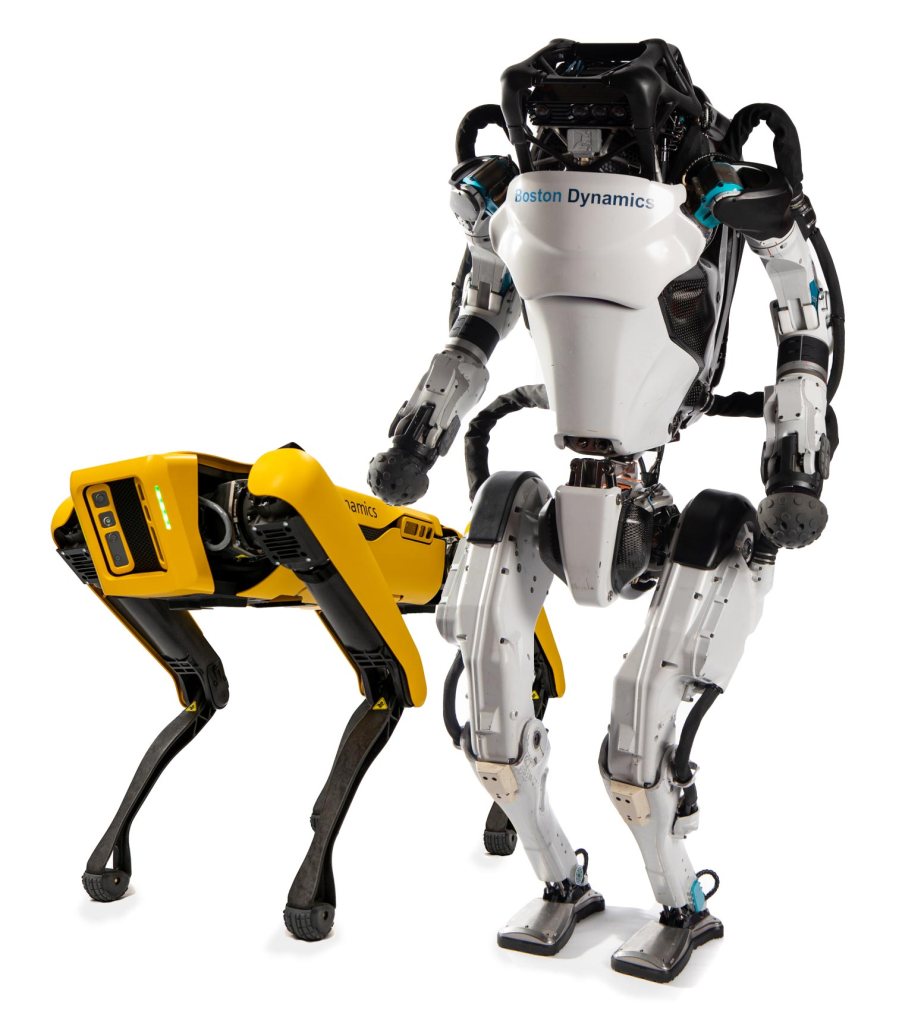
The robots in question are the ones built by Boston Dynamics who shared this video over the holiday period.
For those who have not been watching the development of this companies robots, we get to see the current ‘stars’ of the BD stable, namely: ‘Atlas’ (the humanoid robot), ‘Spot’ (the ‘dog’, who else?) and ‘Handle’ (the one on wheels) all coming together for a nice little Christmassy dance.
(As an aside, if you didn’t quite get what you wanted from Santa this year, you’ll be happy to know you can have your very own ‘Spot’ for a cool $74,500.00 from the Boston Dynamics online shop).
Boston Dynamics is an American engineering and robotics design company founded in 1992 as a spin-off from the Massachusetts Institute of Technology. Boston Dynamics is currently owned by the Hyundai Motor Group (since December, 2020) having previously been owned by Google X and SoftBank Group, the Japanese multinational conglomerate holding company.
Before I get to the point of this post, and attempt to answer the question posed by it, it’s worth knowing that five years ago the US Marine Corps, working with Boston Dynamics who were under contract with DARPA, decided to abandon a project to build a “robotic mule” that would carry heavy equipment for the Marines because the Legged Squad Support System (LS3) was too noisy. I mention this for two reasons: 1) that was five years ago, a long time in robotics/AI/software development terms and 2) that was a development we were actually told about, what about all those other military projects that are classified that BD may very well be participating in? More of this later.
So back to the central question: should we worry about those dancing robots? My answer is a very emphatic ‘yes’, for three reasons.
Reason Number One: It’s a “visual lie”
The first reason is nicely summed up by James J. Ward, a privacy lawyer, in this article. Ward’s point, which I agree with, is that this is an attempt to convince people that BD’s products are harmless and pose no threat because robots are fun and entertaining. Anyone who’s been watching too much Black Mirror should just chill a little and stop worrying. As Ward says:
“The real issue is that what you’re seeing is a visual lie. The robots are not dancing, even though it looks like they are. And that’s a big problem”.
Ward goes on to explain that when we watch this video and we see these robots appearing to be experiencing the music, the rhythmic motion, the human-like gestures we naturally start to feel the joyfulness and exuberance of the dance with them. The robots become anthropomorphised and we start to feel we should love them because they can dance, just like us. This however, is dangerous. These robots are not experiencing the music or the interaction with their ‘partners’ in any meaningful way, they have simply been programmed to move in time to a rhythm. As Ward says:
“It looks like human dancing, except it’s an utterly meaningless act, stripped of any social, cultural, historical, or religious context, and carried out as a humblebrag show of technological might.”
The more content like this that we see, the more familiar and normal it seems and the more blurred the line becomes between what it is to be human and what our relationship should be with technology. In other words, we will become as accepting of robots as we are now with our mobile phones and our cars and they will suddenly be integral parts of our life just like those relatively more benign objects are.
But robots are different.
Although we’re probably still some way off from the dystopian amusement park for rich vacationers depicted in the film Westworld, where customers can live out their fantasies through the use of robots that provide anything humans want we should not ignore the threat from robots and advanced artificial intelligence (AI) too quickly. Maybe then, videos like the BD one should serve as a reminder that now is the time to start thinking about what sort of relationship we want with this new breed of machine and start developing ethical frameworks on how we create and treat things that will look increasingly like us?
Reason Number Two: The robots divert us from the real issue
If the BD video runs the risk of making us more accepting of technology because it fools us into believing those robots are just like us, it also distracts us in a more pernicious way. Read any article or story on the threats of AI and you’ll aways see it appearing alongside a picture of a robot, and usually one that Terminator like is rampaging around shooting everything and everyone in sight. The BD video however shows that robots are fun and that they’re here to do work for us and entertain us, so let’s not worry about them or, by implication, their ‘intelligence’.
As Max Tegmark points out in his book Life 3.0 however, one of the great myths of the dangers of artificial intelligence is not that robots will rise against us and wage out of control warfare Terminator style, it’s more to do with the nature of artificial intelligence itself. Namely, that an AI whose goals are misaligned with our own, needs no body, just an internet connection, to wreak its particular form of havoc on our economy or our very existence. How so?
It’s all to do with the nature of, and how we define, intelligence. It turns out intelligence is actually quite a hard thing to define (and more so to get everyone to agree on a definition). Tegmark uses a relatively broad definition:
intelligence = ability to accomplish complex goals
and it then follows that:
artificial intelligence = non-biological intelligence
Given these definitions then, the real worry is not about machines becoming malevolent but about machines becoming very competent. In other words what about if you give a machine a goal to accomplish and it decides to achieve that goal no matter what the consequences?
This was the issue so beautifully highlighted by Stanley Kubrick and Arthur C. Clarke in the film 2001: A Space Odyssey. In that film the onboard computer (HAL) on a spaceship bound for Jupiter ends up killing all of the crew but one when it fears its goal (to reach Jupiter) maybe jeopardised. HAL had no human-like manifestation (no arms or legs), it was ‘just’ a computer responsible for every aspect of controlling the spaceship and eminently able to use that power to kill several of the crew members. As far as HAL was concerned it was just achieving its goal – even if it did mean dispensing with the crew!
It seems that hardly a day goes by without there being news of not just our existing machines becoming ever more computerised but with those computers becoming ever more intelligent. For goodness sake, even our toothbrushes are now imbued with AI! The ethical question here then is how much AI is enough and just because you can build intelligence into a machine or device, does that mean you actually should?
Reason Number Three: We maybe becoming “techno-chauvinists”
One of the things I always think when I see videos like the BD one is, if that’s what these companies are showing is commercially available, how far advanced are the machines they are building, in secret, with militaries around the world?
Is there a corollary here with spy satellites? Since the end of the Cold War, satellite technology has advanced to such a degree that we are being watched — for good or for bad — almost constantly by military, and commercial organisations. Many of the companies doing the work are commercial with the boundary between military and commercial now very blurred. As Pat Norris, a former NASA engineer who worked on the Apollo 11 mission to the moon and author of Spies in the Sky says “the best of the civilian satellites are taking pictures that would only have been available to military people less than 20 years ago”. If that is so then what are the military satellites doing now?
In his book Megatech: Technology in 2050 Daniel Franklin points out that Western liberal democracies often have a cultural advantage, militarily over those who grew up under a theocracy or authoritarian regime. With a background of greater empowerment in decision making and encouragement to learn from, and not be penalised by, mistakes, Westerners tend to display greater creativity and innovation. Education systems in democracies encourage the type of creative problem-solving that is facilitated by timely intelligence as well as terabytes of data that is neither controlled nor distorted by an illiberal regime.
Imagine then how advanced some of these robots could become, in military use, if they are trained using all of the data available to them from past military conflicts, both successful and not so successful campaigns?
Which brings me to my real concern about all this. If we are training our young scientists and engineers to build ‘platforms’ (which is how Boston Dynamics refers to its robots) that can learn from all of this data, and maybe to begin making decisions which are no longer understood by their creators, then whose responsibility is it when things go wrong?
Not only that, but what happens when the technology that was designed by an engineering team for a relatively benign use, is subverted by people who have more insidious ideas for deploying those ‘platforms’? As Meredith Broussard says in her book Artificial Unintelligence: “Blind optimism about technology and an abundant lack of caution about how new technologies will be used are a hallmark of techno-chauvinism”.
As engineers and scientists who hopefully care about the future of humanity and the planet on which we live surely it is beholden on us all to morally and ethically think about the technology we are unleashing? If we don’t then what Einstein said at the advent of the atomic age rings equally true today:
“It has become appallingly obvious that our technology has exceeded our humanity.”
Albert Einstein
